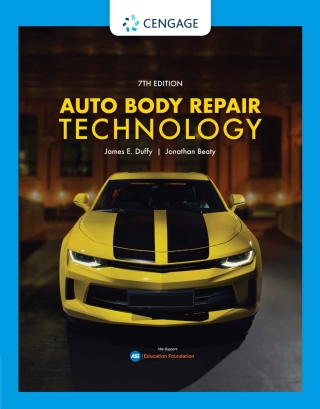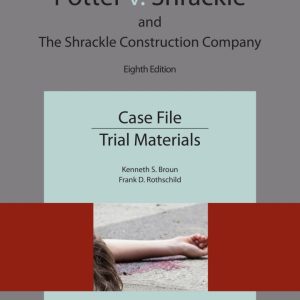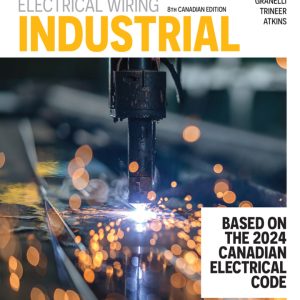Buy Auto Body Repair Technology, 7th Edition PDF ebook by author James E. Duffy; Jonathan Beaty – published by Cengage Learning in 2021 and save up to 80% compared to the print version of this textbook. With PDF version of this textbook, not only save you money, you can also highlight, add text, underline add post-it notes, bookmarks to pages, instantly search for the major terms or chapter titles, etc.
You can search our site for other versions of the Auto Body Repair Technology, 7th Edition PDF ebook. You can also search for others PDF ebooks from publisher Cengage Learning, as well as from your favorite authors. We have thousands of online textbooks and course materials (mostly in PDF) that you can download immediately after purchase.
Note: e-textBooks do not come with access codes, CDs/DVDs, workbooks, and other supplemental items.
eBook Details:
Full title: Auto Body Repair Technology, 7th Edition
Edition: 7th
Copyright year: 2021
Publisher: Cengage Learning
Author: James E. Duffy; Jonathan Beaty
ISBN: 9780357139790, 9780357139899
Format: PDF
Description of Auto Body Repair Technology, 7th Edition:
AUTO BODY REPAIR TECHNOLOGY, Seventh Edition, features extensive new and updated material reflecting the latest automotive technology and current industry best practices. In addition to incorporating current ASE Education Foundation Collision Repair and Refinish Program Standards and Task Lists, this market-leading text provides detailed information on working with hybrid and electric vehicles, using environmentally friendly water-based paints, resistance spot and nitrogen plastic welding and other cutting-edge methods and materials. Celebrated for its clear, reader-friendly explanations and detailed, accurate information, this proven guide also includes abundant full-color photos and illustrations–many new or updated for the Seventh Edition–to make even complex concepts easier to understand and apply. Providing comprehensive coverage of collision repair–from initial evaluation and estimating, to structural and mechanical repairs, to repainting and refinishing–this trusted guide helps readers quickly and confidently learn the skills and procedures they need to succeed as professional automotive technicians.Important Notice: Media content referenced within the product description or the product text may not be available in the ebook version.
Table of Contents of Auto Body Repair Technology, 7th Edition PDF ebook:
ContentsPrefaceAcknowledgmentsFeatures of the TextSupplementsSection 1: Non-Structural Analysis and Damage RepairChapter 1: Colision Repair: Introduction and Careers1.1 What Is Collision Repair?1.2 Collision Center Repairs1.3 Collision Repair Careers1.4 Collision Repair Goals1.5 Worker Characteristics1.6 Industry CertificationsKey TermsASE-Style Review QuestionsEssay QuestionsCritical Thinking ProblemsMath ProblemsActivitiesChapter 2: Shop Safety2.1 Shop Accidents2.2 Personal Safety2.3 General Shop Safety Procedures2.4 Tool and Equipment Safety2.5 Fire Safety2.6 Hazardous Material Safety2.7 Good Shop Housekeeping2.8 Air Bag SafetyKey TermsASE-Style Review QuestionsEssay QuestionsCritical Thinking ProblemsMath ProblemsActivitiesChapter 3: Vehicle Construction Technology3.1 Body and Chassis3.2 Vehicle Frame3.3 Major Body Sections3.4 Body Classifications3.5 Auto Body Repair History3.6 Unibody Panels3.7 Unibody Design Factors3.8 Body-Over-Frame Considerations3.9 Crash TestingKey TermsASE-Style Review QuestionsEssay QuestionsCritical Thinking ProblemsMath ProblemsActivitiesChapter 4: Service Information, Specifications, and Measurements4.1 Service Information4.2 Vehicle Identification4.3 Using Service Information4.4 Collision Repair MeasurementsKey TermsASE-Style Review QuestionsEssay QuestionsCritical Thinking ProblemsMath ProblemsActivitiesChapter 5: Hand Tools5.1 General Purpose Tools5.2 Bodyworking Tools5.3 Body Surfacing Tools5.4 Hand Tool SafetyKey TermsASE-Style Review QuestionsEssay QuestionsCritical Thinking ProblemsMath ProblemsActivitiesChapter 6: Power Tools and Equipment6.1 Air-Powered Tools6.2 Electric-Powered Tools6.3 Hydraulically Powered Shop Equipment6.4 Power Jacks and Straightening Equipment6.5 Hydraulic Tool Care6.6 Hydraulic LiftsKey TermsASE-Style Review QuestionsEssay QuestionsCritical Thinking ProblemsMath ProblemsActivitiesChapter 7: Compresed Air System Technology7.1 The Air Compressor7.2 Air and Fluid Control Equipment7.3 Compressor Accessories7.4 Air System Maintenance7.5 Air System SafetyKey TermsASE-Style Review QuestionsEssay QuestionsCritical Thinking ProblemsMath ProblemsActivitiesChapter 8: Colision Repair Materials and Fasteners8.1 Refinishing Materials8.2 FastenersKey TermsASE-Style Review QuestionsEssay QuestionsCritical Thinking ProblemsMath ProblemsActivitiesChapter 9: Outer Body Panel Service9.1 How Are Fastened Parts Serviced?9.2 Hood Service9.3 Bumper Service9.4 Fender Service9.5 Grille Service9.6 Deck Lid and Hatch Service9.7 Truck Bed Service9.8 Sound-Deadening Pads9.9 Aftermarket Body Panels9.10 Installing Body Trim and MoldingsKey TermsASE-Style Review QuestionsEssay QuestionsCritical Thinking ProblemsMath ProblemActivitiesChapter 10: Door, Roof, and Moveable Glass Service10.1 Servicing Doors and Liftgates10.2 Liftgates10.3 Door Panel (Skin) Replacement10.4 Panel Adhesive Technology10.5 Door and Door Glass Adjustments10.6 Door Glass Service10.7 Rearview Mirror Service10.8 Roof Panel ServiceKey TermsASE-Style Review QuestionsEssay QuestionsCritical Thinking ProblemsMath ProblemsActivitiesChapter 11: Repairing Sheet Metal11.1 Automotive Sheet Metal11.2 Classifying Body Damage11.3 Analyzing Sheet Metal Damage11.4 Metal Straightening Techniques11.5 Metal Shrinking, Stress Relieving11.6 Working Aluminum Panels11.7 Paintless Dent RemovalKey TermsASE-Style Review QuestionsEssay QuestionsCritical Thinking ProblemsMath ProblemsActivitiesChapter 12: Using Body Fillers12.1 Body Fillers12.2 Applying Body Filler12.3 Grating and Sanding Body Filler12.4 Repairing Paint Surface Imperfections12.5 Repairing Rust DamageKey TermsASE-Style Review QuestionsEssay QuestionsCritical Thinking ProblemsMath ProblemsActivitiesChapter 13: Plastic Repair13.1 Types of Plastics13.2 Plastic Repair13.3 Chemical-Adhesive Bonding Techniques13.4 Plastic Welding13.5 Hot-Air Plastic Welding13.6 Airless Plastic Welding13.7 Ultrasonic Plastic Welding13.8 Plastic Welding Procedures13.9 Repairing Vinyl13.10 Ultrasonic Stud Welding13.11 Reinforced Plastic RepairKey TermsASE-Style Review QuestionsEssay QuestionsCritical Thinking ProblemsMath ProblemActivitiesChapter 14: Passenger Compartment Service14.1 Passenger Compartment Assemblies14.2 Interior Trim14.3 Roll Bars14.4 Seat Service14.5 Carpeting Service14.6 Dash Panel Service14.7 Console Service14.8 Instrument Cluster Service14.9 Headliner Service14.10 Locating Air and Water Leaks14.11 Rattle EliminationKey TermsASE-Style Review QuestionsEssay QuestionsMath ProblemsCritical Thinking ProblemsActivitiesSection 2: WeldingChapter 15: Welding Technology15.1 Joining Metals15.2 Mig Welding15.3 Mig Welding Equipment15.4 Mig Operation Methods15.5 Basic Welding Techniques15.6 Mig Welding Galvanized Metals and Aluminum15.7 Testing the Mig Weld15.8 Mig Weld Defects15.9 Flux-Cored Arc Welding15.10 Tig Welding15.11 Resistance Spot Welding15.12 Other Spot Welding Functions15.13 Oxyacetylene Welding15.14 Brazing15.15 Soldering (Soft Brazing15.16 Plasma Arc CuttingKey TermsASE-Style Review QuestionsEssay QuestionsCritical Thinking ProblemsMath ProblemsActivitiesSection 3: Structural Analysis and Damage RepairChapter 16: Structural Glass Service16.1 Vehicle Glass Technology16.2 Glass ServiceKey TermsASE-Style Review QuestionsEssay QuestionsCritical Thinking ProblemsActivitiesChapter 17: Body/Frame Damage Measurement17.1 Impact and Its Effects on a Vehicle17.2 Visually Determining the Extent of Impact Damage17.3 Measurement of Body Dimensions17.4 Gauge Measuring Systems17.5 Tram Gauges17.6 Digital Tram Gauges17.7 Centering Gauges17.8 Diagnosing Damage Using Gauge Measuring Systems17.9 Strut Centerline Gauge17.10 Universal Measuring Systems17.11 Computerized Measuring SystemsKey TermsASE-Style Review QuestionsEssay QuestionsCritical Thinking ProblemsMath ProblemsActivitiesChapter 18: Unibody/Frame Repair and Realignment18.1 Realignment Basics18.2 Unibody/Frame Straightening Equipment18.3 Straightening and Realigning Techniques18.4 Measuring When Pulling18.5 Planning the Pull18.6 Making Pulls18.7 Executing a Pulling Sequence18.8 Stress RelievingKey TermsASE-Style Review QuestionsEssay QuestionsCritical Thinking ProblemsMath ProblemsActivitiesChapter 19: Welded Panel Replacement19.1 Welded Panels19.2 Removing Structural Panels19.3 Preparing Panels for Welding19.4 Structural Sectioning19.5 Sectioning Side Members (Frame Rails19.6 Rear Impact Damage Repair19.7 Antirust Treatments19.8 Replacing Panels with AdhesivesKey TermsASE-Style Review QuestionsEssay QuestionsCritical Thinking ProblemsMath ProblemsActivitiesChapter 20: Restoring Corrosion Protection20.1 What Is Corrosion?20.2 Causes for Loss of Factory Protection20.3 Anticorrosion Materials20.4 Basic Surface Preparation20.5 Corrosion Treatment Areas20.6 Corrosion-Protection Primers20.7 Exposed Joints20.8 Exposed Interior Surfaces20.9 Exposed Exterior Surfaces20.10 Exterior Accessories20.11 Acid Rain DamageKey TermsASE-Style Review QuestionsEssay QuestionsCritical Thinking ProblemsMath ProblemsActivitiesSection 4: Mechanical and ElectricalChapter 21: Chassis Service and Wheel Alignment21.1 Powertrain Construction21.2 Suspension and Steering Systems21.3 Wheel Alignment21.4 Brake Systems21.5 Cooling Systems21.6 Heater Operation21.7 Air-Conditioning Systems21.8 Exhaust Systems21.9 Emission Control Systems21.10 Hose and Tubing Inspection21.11 Fuel System ServiceKey TermsASE-Style Review QuestionsEssay QuestionsCritical Thinking ProblemsMath ProblemsActivitiesChapter 22: Electrical System Operation and Service22.1 Electrical Terminology22.2 Checking Electrical Problems22.3 Battery22.4 Electrical Diagnostic Equipment22.5 Electric Components22.6 Circuit Protective Devices22.7 Lighting and Other Electrical Circuits22.8 Electronic System Service22.9 Electronic Displays22.10 Computer Systems22.11 Advanced Driver-Assistance SystemsKey TermsASE-Style Review QuestionsEssay QuestionsCritical Thinking ProblemsMath ProblemsActivitiesChapter 23: Restraint System Operation and Service23.1 Seat Belt Systems23.2 Seat Belt Service23.3 Air Bag System Operation23.4 Servicing Air Bag Systems23.5 Active Head Restraints23.6 Adaptive Steering Columns23.7 Roll Bar ServiceKey TermsASE-Style Review QuestionsEssay QuestionsCritical Thinking ProblemsMath ProblemsActivitiesChapter 24: Hybrid and Electric Vehicle Service24.1 What Is a Hybrid Vehicle?24.2 History of Electric-Powered Vehicles24.3 Beginning Repairs24.4 Repair Strategies for Hybrid and Electric Vehicles24.5 Safe Practices and General Repairs for Hybrid and Electric Vehicles24.6 Paint Booth Concerns24.7 General Recommendations for HV Battery Removal and Replacement24.8 Final ChecksKey TermsASE-Style Review QuestionsEssay QuestionsCritical Thinking ProblemsMath ProblemsActivitiesSection 5: Damage Analysis and EstimatingChapter 25: Damage Analysis and Estimating Service 25.1 The Estimate25.2 Part Prices25.3 Labor Costs25.4 Refinishing Time25.5 Estimate Total25.6 Computer Estimating25.7 Computer Database25.8 Estimating Sequence25.9 Vehicle Total Loss25.10 Damage Analysis and Repair BlueprintingKey TermsASE-Style Review QuestionsMath ProblemsActivitiesEssay QuestionsCritical Thinking ProblemsSection 6: Painting and RefinishingChapter 26: Refinishing Equipment26.1 Spray Guns26.2 Equipment and Material Preparation26.3 Spray Gun Setup26.4 Using a Spray Gun26.5 Spray Gun Maintenance26.6 Spray Gun Troubleshooting26.7 Other Spray Systems26.8 Spray Booths26.9 Spray Booth Maintenance26.10 Drying Room26.11 Air-Supplied Respirators26.12 Other Paint Shop Equipment and ToolsKey TermsASE-Style Review QuestionsEssay QuestionsCritical Thinking ProblemsMath ProblemsActivitiesChapter 27: Surface Preparation and Masking 27.1 Evaluate Surface Condition27.2 Paint Removal27.3 Preparing Bare Metal27.4 Primecoat Selection27.5 Final Sanding27.6 Masking27.7 Surface Cleaning27.8 EPA 6H RulesKey TermsASE-Style Review QuestionsEssay QuestionsCritical Thinking ProblemsMath ProblemsActivitiesChapter 28: Refinishing Procedures 28.1 Purpose of Refinishing28.2 Topcoats28.3 Primecoats28.4 Preparing Refinish Materials28.5 Prepainting Preparations28.6 Applying Primecoats28.7 Refinishing Plastic Parts28.8 Flash Times28.9 Basic Spray Coats28.10 Methods of Refinishing28.11 Basecoat/Clearcoat Repairs28.12 Applying Single-Stage Paints28.13 Panel Repairs28.14 Overall Refinishing28.15 Removal of Masking MaterialsKey TermsASE-Style Review QuestionsEssay QuestionsCritical Thinking ProblemsMath ProblemsActivitiesChapter 29: Color Matching and Custom Painting 29.1 Color Theory29.2 Using a Paint Color Directory29.3 Matching Basic Paint Colors29.4 Matching Basecoat/Clearcoat Finishes29.5 Matching Three-Stage Paints29.6 Tinting29.7 Custom PaintingKey TermsASE-Style Review QuestionsEssay QuestionsCritical Thinking ProblemsMath ProblemsActivitiesChapter 30: Paint Problems and Final Detailing 30.1 Repairing Paint Problems30.2 Masking Problems30.3 Final Detailing30.4 Paint Compounding30.5 Final Cleaning30.6 Caring for a New FinishKey TermsASE-Style Review QuestionsCritical Thinking ProblemsMath ProblemActivitiesAppendix A: Abbreviations Used by Body Technicians and EstimatorsAppendix B: Decimal and Metric EquivalentsAppendix C: Viscosity Conversion ChartGlosary/GlosarioIndex





